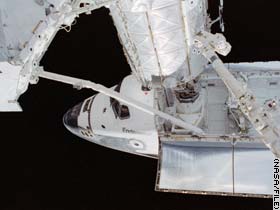NASA Administrator Sean O'Keefe said that the improvements, adjustments and repairs in the three remaining shuttles have already cost NASA an amount of 1.5 billion dollars.

A NASA panel sees no obstacle to a return to space
There is no serious obstacle in the way of NASA launching a shuttle in May or June this year, representatives of a task force investigating the efforts to return to space said on Friday, but the team still expresses concern about the crew members' ability to carry out repairs in space if they are required.
"There are no visible obstacles to returning to flight," said Richard Covey, co-chairman of the task force.
Kobi says that one issue that may still come up is the availability of possible repair techniques."
NASA has set a launch window for Discovery for May or June, which will be the first shuttle to be launched since the Columbia disaster.
The seven Discovery astronauts have a hole-repair kit, although it is not approved and is too basic. If they cannot return to Earth, they will have the option of entering the International Space Station and waiting there for rescue by the shuttle Atlantis a month later.
NASA still needs to fulfill eight of the 15 recommendations of the Commission of Inquiry into the Columbia disaster. Among the items on which the work has not been completed, preventing the fragments from falling from the fuel tank and hardening the shuttle itself.
However, NASA is close to completing some of these recommendations and will be able to complete them before the launch window, Kobi said. Kobe's committee is supposed to deliver the follow-up report on NASA's progress towards the launch, around April.
Commitment to building the space station
NASA has confirmed to its partners for the International Space Station that it plans to return the shuttles to flight this year and that two test launches will be carried out - in the spring and summer, while the renewal of the International Space Station train will be carried out with a shuttle flight planned for December.
The meeting in Montreal was attended by representatives of five space agencies that are partners in the project and represent 16 countries: USA, Russia, Europe, Japan and Canada. The representatives said that they are confident that the assembly of the space station will be completed by the end of the decade despite the grounding expected to continue for about two and a half years of the shuttles since the Columbia disaster, on February 1, 2003.
NASA Administrator Sean O'Keefe said that the improvements, adjustments and repairs in the three remaining shuttles have already cost NASA an amount of 1.5 billion dollars.
The heads of the five agencies emphasized their commitment to the space station, the cost of which far exceeded the planned amounts due to the project's dependence on shuttles for construction work.
Europe and Japan are waiting for a launch to bring up their main laboratories, work of which the capacity of the shuttles is needed.
Before leaving his position, O'Keefe praised the continued functioning of the station in the past two years despite the tattooing of the shuttles and said that this proves that the partnership in the station allows for flexibility. He said that NASA is committed to providing the systems of the other partners to the station before the shuttles are retired. He reiterated that the U.S. goal is to take the shuttles out of service in 2010 after making the "lowest possible number of flights" necessary to fulfill the U.S. obligations to build the station.
O'Keefe said that the US will use the experience gained and accumulated at the station to develop a space exploration program that will focus on the Moon and Mars and not in low Earth orbit.
The director of the Russian Federal Space Agency, Enoli Ferminov, said that Russia agrees that the station is useful as a laboratory for long space missions. However, he said that any manned mission to Mars could only take place after continuous work in low orbit around the Earth on facilities such as the International Space Station. Paraminov said that Russia's immediate goal after the International Space Station is a human presence on the moon. He said that space stations, even though they orbit the Earth in low orbit, will take a long time to gain enough experience to allow sending humans to Mars.
